“Town braces itself for arrival of gypsies†ran the headline in the Wilts and Gloucestershire Standard last week in reference to the bi-annual Stow Gypsy Horse Fair. The Cotswold town of Stow-on-the-Wold has held the fair since 1476, when it was granted a royal charter and it took place this year on Thursday 15th May.
Thousands of travellers, most of them Romany gypsies, descend upon this decidedly conservative town, arriving in the modern caravans and lorries which have largely replaced the brightly painted wagons that visitors would have seen thirty years ago. The gypsies trade horses and erect tents and stalls selling goods ranging from plastic toys to fake mink coats for children.
In recent years local residents have expressed increasing dissatisfaction with the disruption the fair brings. Political correctness is abandoned as they talk of ‘thieving gypsies’ and wonder at the fact that many of the travellers cannot read or write properly. In 2000, a court injunction threatened every trader at the fair with imprisonment if they camped overnight in the field in which it is held. The gypsies got around this simply by buying the field.
At Stow’s Tourist Information Centre the polite, well-dressed lady manning the desk informed us that the event wasn’t welcome but that the authorities were powerless to stop it. She talked of businesses deciding to close, rather than face theft or damage to their properties and sure enough, most of the shops, B&Bs and local pubs all had hand-written ‘closed’ signs hanging in the window.Â
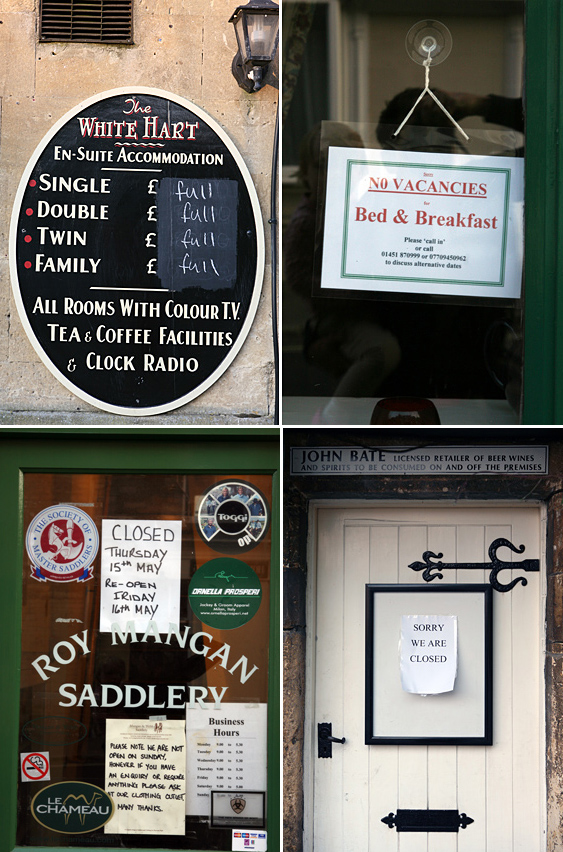
I particularly liked the unnecessarily elaborate notes pinned in some shop windows. “We are now closed due to kitchen refurbishment and re-open Friday 16th May†(the day after the festival) and “The Crock will be closed on May 13th, 14th and 15th for alterations and improvements†(no sign of alterations when I passed).
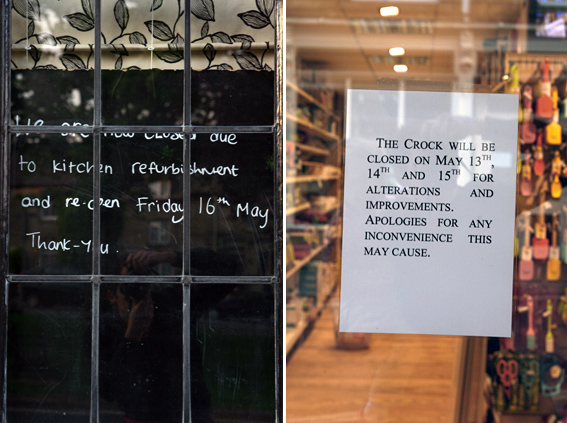
Our camper van provoked an amusing reaction. Parking up for the night at Stow Rugby Club, we were approached by a member of the club to check that we’d paid. We assured him everything was in order. “Oh,†he said unapologetically, “I thought you were with the fair.â€Â Then, reassured of our ‘respectability’, “If you go, watch your pockets. Some of those kids will have your wallet in an instant.â€
A few days later, while staying on a small campsite in the Forest of Dean, we heard the unmistakable beat of a large sound system booming out in the middle of the night. An all night rave in this ‘heart-shaped land’ that inspired the term ‘picturesque’ and all those genteel 18th and 19th century tours! (see footnote below).  Our fellow campers were not impressed. The owner of the campsite relayed the latest information in disparaging terms every time her telephone rang.
I cycled off in search of this spectacle, lugging my tripod and camera on my back. It took me an hour to find it, but it was worth it, greeted as I was by the surreal sight of a transit van spilling out huge speakers, around which were gathered about fifty people all distinctly the worse for wear, head banging and lolling around, but in a beautiful pine clearing in the forest. I managed a few pictures before the police arrived and stopped the proceedings. (For an online article about raves in the Forest of Dean see this link).
It’s clear that most people do not want unofficial, disruptive and noisy events taking place within the vicinity of their homes. They worry about damage to property and land. But I felt that such events enrich our cultural and social landscape, which can seem increasingly sterile and regimented, and are expressions of diversity of people and place and as such, should be enjoyed (responsibly, of course!)
Â
Footnote- The Birthplace of British Tourism
The Wye Valley and Forest of Dean witnessed the birth of British tourism in the eighteenth century. The area became widely known following the publication in 1782 of Observations on the River Wye by the Reverend William Gilpin. The first illustrated tour guide to be published in Britain, it helped travellers locate and enjoy the most “picturesque” aspects of the countryside. The Wye Valley’s particular attraction was its river scenery, and the many guidebooks, engravings and paintings ensured a continuing steady stream of visitors which grew after the building of a new turnpike road up the valley in 1822 and the opening of a rail line in 1865.
Â
Posted in EVENTS & PASTIMES | Comments Off on NOT IN MY BACKYARD
We’ve just completed our first three weeks on the road having covered ground in Hampshire, Berkshire, Gloucestershire, Worcestershire and Herefordshire.
Here’s a family portrait (rather twee I know) taken outside the motorhome in the Forest of Dean.
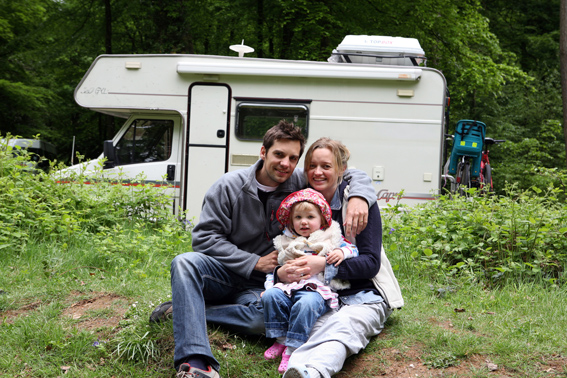
In the coming weeks we’ll be heading south into Wiltshire then across to Somerset, Devon and down into Dorset.
If you know of any interesting events taking place in these areas, then do post them up.Â
Â
Posted in POSTCARDS | Comments Off on JOURNEY UPDATE – WEEK 3
Here are a few quotes I’ve come across in my research over past few weeks, which I’ve found particularly interesting or inspirational. If you have any other suggestions, please post them below.
“Happy are those who see beauty in modest spots where others see nothing. Everything is beautiful, the whole secret lies in knowing how to interpret.â€Â
Pissarro (1893). Quoted in Britain Observed by Geoffrey Grigson (1975)
“My limited and abstracted art is to be found under every hedge, and in every lane, and therefore nobody thinks it worth picking up.â€Â
Constable (1832) on declaring he had never seen an ugly thing in his life. Quoted in Britain Observed by Geoffrey Grigson (1975)
“It is part of the photographer’s job to see more intensely than most people do. He must have and keep in him something of the receptiveness of the child who looks at the world for the first time or of the traveller who enters a strange country.â€Â
Bill Brandt (1948)
“One of the pleasures of being English is to return to this country after a longish time abroad, especially if you come up the Solent in a liner….soon familiarity blinds you again, but for an hour ot two you have caught a surprising vision of your country and your countrymen: you have notice a hundred details which are peculiar to England; you have, in fact been able to look through foreign eyes.â€Â
Raymond Mortimer from the introduction to Bill Brandt’s The English at Home (1936)
 “England has a much softer atmosphere. Colours just don’t sing the way they do in the States…When I got back to England I found everything so grey that I didn’t see any point in shooting in colour. It didn’t seem to be an important part of our lives….To me Britian is very much a black and white country…â€Â
Tony Ray-Jones from an interview in SLR Camera (1969)
 “We must live in a country and work there in order to understand its ways and customs – to travel through as a tourist is to see only clichés.â€Â
Tony Ray-Jones, Notes on Jean Renoir (c.1967)
 “One can learn a good deal about the spirit of England from the comic coloured postcards that you see in the windows of cheap stationers’ shops. These things are a sort of diary upon which the English people have unconsciously recorded themselves. Their old-fashioned outlook, their graded snobberies, their mixture of bawdiness and hypocrisy, their extreme gentleness, their deeply moral attitude to life, are all mirrored there.â€Â
George Orwell, The Lion and the Unicorn (1941)
“Englishness is continuous, it stretches into the future and the past, there is something in it that persists; as in a living creature. What can the England of 1940 have in common with the England of 1840? But then, what have you in common with the child of five whose photograph your mother keeps on the mantelpiece? Nothing, except that you happen to be the same person.â€Â
George Orwell, The Lion and the Unicorn (1941)
 “England is not at all a single category but a set of relationships. The nation exists in tension. Its fellow members remain deeply divided among themselves, but at the same time they constantly prove themselves ready to unite around certain issues, talismans and images.â€Â
John Taylor, A Dream of England (1994)
“The English have not devoted a lot of energy discussing who they are. It is a mark of self-confidence: the English have not spent a great deal of time defining themselves because they haven’t needed to.â€Â Â
Jeremy Paxman, The English (1999)
“In a society of individuals, loyalties are to kindred spirits. Instead of easy-going, random meetings of street life, the English do their socialising by choice and form clubs – ‘Who runs the country?’ asked John Betjeman rhetorically. ‘The RSPB. Their members are behind every hedge.’ And he was speaking long before the RSPB membership reached its present vertiginous levels of well over one million. There are clubs to going fishing, support football teams, play cards, arrange flowers, race pigeons, make jam, ride bicycles, watch birds, even for going on holiday.â€Â
Jeremy Paxman, The English (1999)
“I hope that this apparently incongruous series of images will communicate something of the mixture of anxiety and apprehension, sadness and affection with which I view the current state of our nation.â€Â
Paul Graham from the introduction to Britain in 1984 co-published by the National Media Museum and The Photographers’ Gallery (1984)
Posted in ENGLISHNESS, INSPIRATION, RESEARCH | 1 Comment »
An overnight stay in Moreton-in-Marsh this week gave us an opportunity to take in the John Davies Gallery (no relation to the photographer), which specializes in post-Impressionist and contemporary art. They were in the midst of hanging a new show by the artist William Selby, however, they also had a permanent collection of paintings on display. One painting that stood out was ‘Fair at Cromer’ by Robert Duckworth Greenham (1906 – 1975).Â
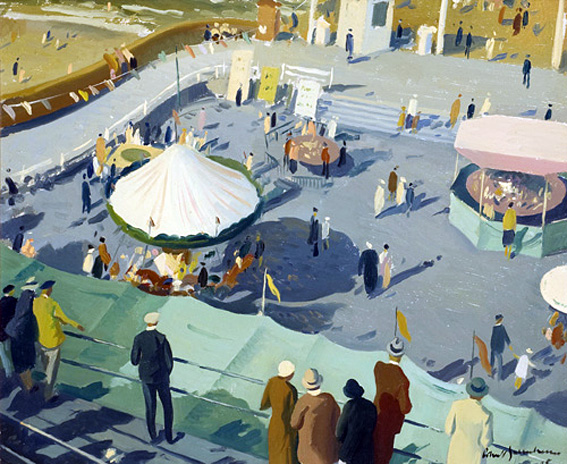
Greenham was a painter and print maker who studied at Byam Shaw School and at the Royal Academy Schools. He was especially fond of painting beach scenes, his slightly stylised draughtmanship and unique palette being instantly recognisable. His brother was the artist Peter Greenham.
Posted in INSPIRATION | Comments Off on FAIR AT CROMER
We’re currently in the Malvern Hills, marketed by the local council as ‘Elgar Country’. According to Brian Micklethwaite, writing on the Icons of England website “The Malvern Hills epitomise England’s ‘green and pleasant land’. They are not an icon solely devoted to London but represent all England, especially when associated with the quintessentially English music of Sir Edward Elgar.â€
We were in Malvern visiting some old friends of ours, Margarette Rolle and her partner Vassily Savenko. Margarette is the promoter of the Boyan Ensemble of Kiev (I spent a month on tour with the Ensemble in 1997 producing one of my first photo essays after graduating). Vassily is an acclaimed bass baritone.
During our stay I spotted a poster in a local shop window advertising a sponsored walk across the Malvern Hills in aid of St. Richard’s Hospice. I went along this morning to watch as a few hundred people walked across this stunning landscape to raise money for the hospice, which cares for patients and families in Worcestershire who are living with cancer and other life-threatening illnesses. As Judy Hughes, one of the walkers I met, said to me “In my opinion spending your leisure time helping others is one of the most rewarding and enjoyable things to do”.
It’s only right to leave you with a link to the Malvern Hills and Elgar.
Posted in EVENTS & PASTIMES | Comments Off on ELGAR COUNTRY
I need to thank three institutions for their kind financial support, which is helping to make the production of We English possible.
Firstly, I recently received a bursary from the National Media Museum in Bradford. Greg Hobson, Curator of Photographs at the Museum describes the bursary as “part of the Museum’s ongoing commitment to photography and to increase awareness of contemporary photography by promoting the work of emerging photographers. The bursaries will help talented photographers produce ongoing projects or a new body of work, allowing them to develop and enhance their practice and profile.†The bursary was judged by a group of key individuals involved in contemporary art: Michael G Wilson (Chairman of the Trustees of the National Media Museum), Zelda Cheatle (WMG Photography Advisor and Curator), Simon Crocker (Chairman of The John Kobal Foundation), Philippe Garner (International Head of Photography, Christie’s Auction House) and Terence Pepper (Curator of Photographs, National Portrait Gallery).
Secondly, Arts Council England for awarding me with an ‘Individual Grant for the Arts’.
And finally to the John Kobal Foundation and their Chairman, Simon Crocker, who have also committed some funds to the project.
Posted in TRIP LOGISTICS | Comments Off on FUNDING
“Welcome to our beautiful town, Chipping Campden in the Cotswolds. Campden is one of the most beautiful tourist destinations in the UK. Take a pictorial tour and get a taste of Olde Cotswold England – but if you really want to appreciate the feeling of staying in an old cotswold stone house in a town, hardly touched by the centuries, you’ll just have to come and visit us.” from www.chippingcampden.co.uk Â
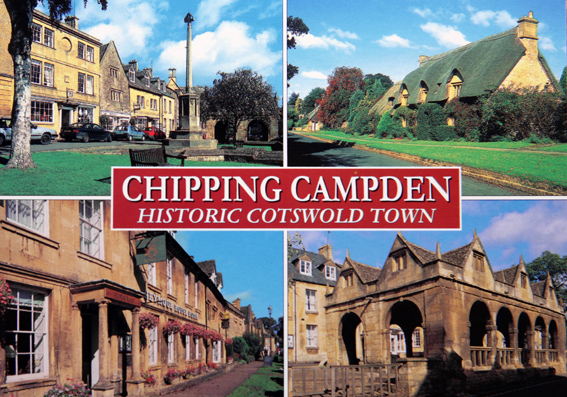
This is one of the only places I’ve come across that actually looks like the postcard. Chipping Campden is eerily picturesque, in a manicured, clipped and tidy way. With so much talk in the media about what it means to be English and about notions of community, identity and stereotypes, it was quite strange to visit a town that felt pathologically, quintessentially English.Â
Posted in POSTCARDS | Comments Off on WELCOME TO OUR BEAUTIFUL TOWN
The 5×4 is proving popular with the public. People come up to me most days when I’m working to ask about the camera. Here’s one elderly gentleman taking a look at my composition.
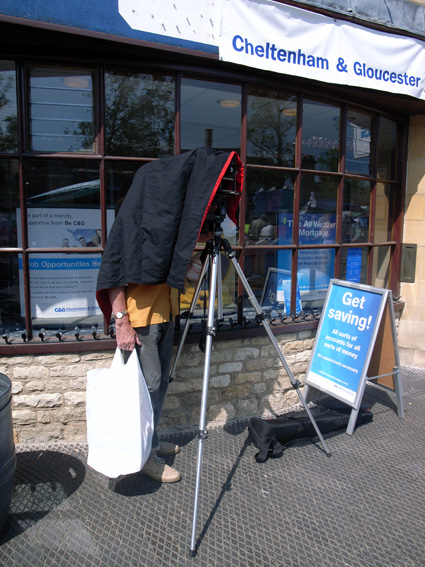
Posted in ON THE JOB | Comments Off on CAN I LOOK AT YOUR CAMERA?
Jemima relaxing at basecamp in Cirencester. Long may this weather continue!
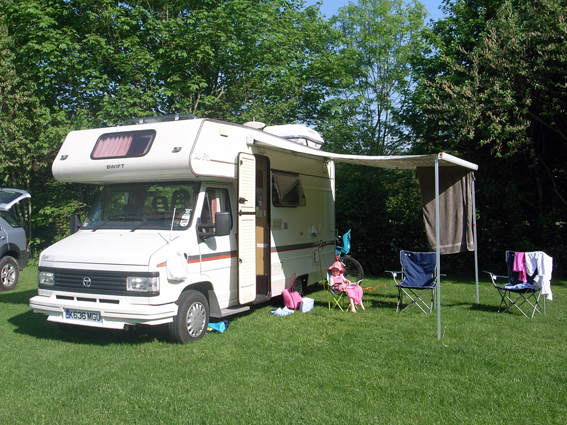
Posted in TRIP LOGISTICS | Comments Off on BASECAMP
Today I was photographing at the Cotswold Water Park, a 40 square mile wetland area south of Cirencester. The Water Park is the catchment area of the Upper Thames. Back in 1967, it was designated the Cotswold Water Park by a Joint Committee formed from the four local authorities – Gloucestershire & Wiltshire County Councils, and Cotswold & North Wilts District Councils. Many of the lakes are flooded gravel excavation pits. Gravel extraction began in the area over 50 years ago. Because the water table is so high, the first quarries were dug wet; today, however, quarries are de-watered. When extraction is complete, all pumps are switched off and the holes fill naturally with water. There are 140 lakes in the park, controlled by 40 different owners, many of whom use their lakes almost entirely as private property, private clubs or for private developments.
I spent most of the day photographing at the Keynes Country Park with its large beach area and lush green wooded backdrop. The lake was packed with families and groups of friends enjoying the May sunshine. The scene reminded me of a photograph I’d taken in Yekaterinburg for my book on Russia, Motherland (also taken in May).

Victory Day Picnic, Yekaterinburg, May 2005
Interestingly enough, having photographed a family barbequeing on the edge of the woodland, I discovered they were actually from Slovakia. Dusen and his wife have lived in Stroud for the past three years where they work as vets. When I asked them about their future plans they told me they’d be returning to Slovakia because they wanted to bring up their children in their ‘homeland’. This sense of belonging echoed the relationship that many Russian’s feel for their ‘motherland’ or rodina in Russian.
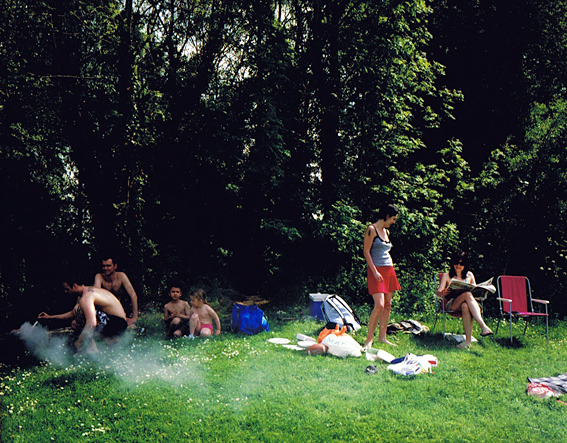
Dusen and his family, Keynes Country Park
Rosamund Bartlett, who wrote the introduction to my book, described the idea of the rodina as such-
“Rodina might just about be the most emotive word in the Russian language. The fact that it is also impossible to translate adequately says something about its close relationship to questions of national destiny, the Russian sense of self and the enduring belief in the country’s messianic future. The Russian motherland is something apart. ‘Every nation has a motherland,’ wrote the religious philosopher Georgy Fedotov in 1915, ‘but only we have Russia.’ The deepest source of patriotism in Russia accordingly lies not in pride in national achievements or military glory, but in love for the motherland, whose most visible expression is the extraordinary, almost physical attachment which Russians have for their native landscape – an attachment which they are often at a loss to fathom.”
This sense of belonging and attachment to a physical place is one of the motivations for my England journey. I suppose in some ways I’m on a quest to discover what my own homeland means to me.
Posted in ENGLISHNESS, ON THE JOB | Comments Off on HOMELAND










